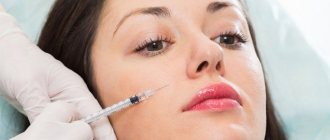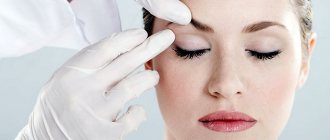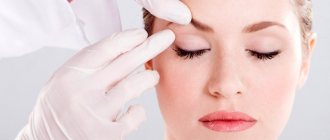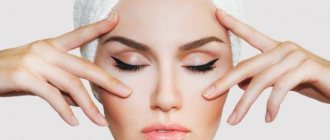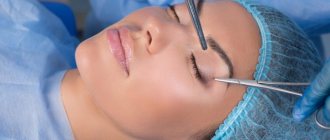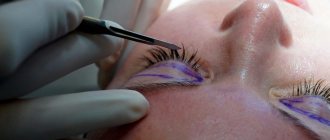No woman wants to put up with age-related changes. And modern plastic surgery helps them stay young, beautiful and inspiring for as long as possible. For example, blepharoplasty - eyelid correction surgery - is designed to remove defects that appear due to age. It improves the shape of the eyelids, gives expressiveness to the eyes, making the face look younger.
Blepharoplasty at the Vita+ clinic (Abakan) will help all patients make their eyes more open and expressive. The procedure is aimed against lower eyelid hernias, it tightens the skin around the eyes and eliminates deep wrinkles.
Indications and contraindications for eyelid correction
The main goal of blepharoplasty is aesthetic; the look after plastic surgery will become more expressive. The second aspect, which is also an indication for eyelid correction, is the presence of excess skin and fat deposits in the area around the eyes. These defects are not only unaesthetic, but lead to a decrease in eye health, as they lead to weakening of the orbicularis oculi muscles.
Indications for blepharoplasty are the following conditions:
- Overhang of the eyelid over the eye;
- The presence of deep wrinkles in the area around the eyes;
- The appearance of multiple facial wrinkles;
- Pathologies of the formation of the upper eyelid with a risk of visual impairment;
- Flabbiness of the skin and the appearance of “bags” under the eyes.
Eyelid surgery also has contraindications:
- Bleeding disorders;
- History of cancer;
- Endocrine system disorders;
- Skin diseases;
- Eye diseases.
Blepharoplasty: additional tests before surgery
In some cases, the doctor may prescribe additional tests, such as:
Fluorography . It will help determine the presence of lung pathologies
Electrocardiogram . Helps identify problems in the cardiovascular system.
If there are ophthalmological problems, a consultation with an ophthalmologist may be prescribed, and additional studies may be carried out to identify somatic pathologies.
Main types of blepharoplasty and their features
Upper eyelid surgery
The procedure is aimed at eliminating the overhanging eyelid, and also allows you to change the shape and shape of the eyes if desired. Designed to get rid of sagging skin in the area around the eyes. After the correction, the seams are almost invisible. It is performed under local anesthesia. After the operation, the patient can be immediately discharged home.
Lower eyelid surgery
It is carried out in 2 ways: using an incision along the eyelid line and using a puncture to remove the fat layer. The first method is aimed at removing excess skin and is used more often. It is performed under local anesthesia. After the operation, the patient can be immediately discharged home.
Circular blepharoplasty
Plastic surgery that helps get rid of several defects at once:
- Wrinkles;
- Asymmetrical;
- Bags under the eyes;
- Excess fat.
Can be performed under general anesthesia.
Correction of failed blepharoplasty
Have you already undergone a similar operation, but did not see the effect? Blepharoplasty can be repeated to improve the results of the previous operation. Interval between operations: 2-3 months. Preparation must also be completed for a repeat operation.
Preparing for blepharoplasty
The duration of the operation depends on the type of blepharoplasty performed and the number of defects being corrected. Before the procedure, the doctor determines the type of skin, its condition, as well as the condition of the muscles and structural features of the skull.
When talking to your doctor, be sure to tell them about any allergies you have or possible adverse reactions to medications. This will help the doctor choose the right type of anesthesia. Before blepharoplasty, it is not recommended to visit beauty salons and carry out a certain number of cosmetic procedures at home.
Before blepharoplasty, we recommend visiting an ophthalmologist and obtaining permission to perform this operation. Pay special attention to the presence of dry eye syndrome and glaucoma. These diseases should also be reported to the surgeon.
If you have a history of diseases such as diabetes, cardiovascular diseases, or endocrine system disorders, then, unfortunately, blepharoplasty is contraindicated for you.
After collecting information about your health, the doctor will talk about the operation, possible consequences and the recovery process. To clarify some conditions, he may prescribe tests, including checking the blood for clotting and the absence of various infections.
Preparation for blepharoplasty includes:
1. Increased water consumption (this recommendation continues after surgery);
2. Stop smoking. Nicotine use slows down the recovery process;
3. You cannot take aspirin, dietary supplements and homeopathic remedies.
If the operation is to be performed under local anesthesia, you will only be required to undergo a series of tests. If general anesthesia is used (for example, in the case of circular blepharoplasty), then in addition to the tests, an ECG and fluorography will be required. Whichever method of anesthesia is chosen, you will receive a preliminary consultation with an anesthesiologist.
What tests should be done and what examinations should I undergo if I have plastic surgery?
Answered by Marina Gennadievna Ukolova, consultant doctor of the Independent Laboratory "INVITRO" in Moscow.
Many women think that plastic surgery is not very serious. It is done for beauty, not for health. Why do you need an examination if a lady just wants to tighten her eyelids a little or get rid of spider veins on her legs?
Yes, many people think so. And when going for plastic surgery, they do not attach due importance to the preliminary examination. Meanwhile, any plastic surgery, even the most harmless one, such as eyelid skin tightening, is a surgical intervention. And it is possible that after it there will be no complications or relapses. Therefore, standard diagnostics before surgery is simply mandatory. What exactly are these tests?
The gold standard for diagnosis before surgery includes five examinations. These are clinical and biochemical blood tests that evaluate the functions of major organs and systems. Based on their results, objective conclusions can be drawn about the general state of health. You also need to do a coagulogram in order to identify the coagulation and anticoagulation functions of the blood. The next step is blood testing for the Rh factor, sexually transmitted diseases, syphilis, HIV, hepatitis B and C. According to the latest rules, without this study, doctors do not have the right to admit the patient not only to surgery, but even to conservative treatment. And the last two studies: general urine analysis and ECG. The first assesses the condition of the urinary system, the second the cardiovascular system. This is a general examination scheme that is mandatory before any surgical intervention. But besides this, there are also additional tests that are necessary in each specific case.
And to be more specific, what tests need to be done before the same eyelid skin tightening?
Since manipulations are carried out in close proximity to the eyes, first of all you need to make sure that everything is in order with them. That is, there are no acute or inflammatory diseases, for example, conjunctivitis. You should also avoid common viral infections in the body, as they can cause complications after surgery. Toxoplasmosis, cytomegalovirus, herpes and chlamydia are especially successful in this. To keep them under control, before plastic surgery you need to donate blood using ELISA and determine the presence of acute and post-phase immunoglobulins.
And if they are active, does that mean I will have to refuse the operation?
Not at all, viral diseases themselves are not a contraindication to surgery. It is only undesirable to do it at the time of exacerbation. If it happens, and in the cold season this happens quite often, the approaches to treatment are the same: antiviral drugs, immunostimulants, vitamins. If studies have shown that viruses are active, then the operation will have to be postponed.
What about removing spider veins? What should you pay attention to before this operation?
The study of D-dimer deserves special attention. The fact is that an increase in this indicator indicates possible problems with blood clotting, deep vein thrombosis, thromboembolism, and heart failure. Or about a tendency to these diseases. It is also advisable to do a blood test for antibodies to phospholipids. Based on its results, one can judge the presence of antiphospholipid syndrome, in which the vessels of the heart, brain, kidneys, liver, and adrenal glands are damaged. This syndrome was discovered quite recently, but now we can say that it is based on blood clotting disorders. And one more nuance that should be kept in mind before surgery on the veins. Spider veins can be the result not only of venous problems, but also of disturbances in the functioning of the liver and gallbladder. To exclude this possibility, you need to do an ultrasound of the liver, gallbladder and pancreas and take a stool test for dysbacteriosis. But again, as in the case of an eyelid lift, all identified problems will not be a reason to refuse surgery. It’s just that then some more treatment methods will be added to the surgeons’ actions.
Another very popular manipulation now is liposuction. What tests should be performed in this case?
Since this operation is associated with the removal of excess fatty tissue, you must first understand the root cause of its appearance. Therefore, it is necessary to take several blood tests. The first one is for hormones to check the hormonal status, the second one is for glycated hemoglobin to detect a possible increase in glucose levels over the past three months. And finally, the third detailed lipid profile: triglycerides, cholesterol, high and low density lipoproteins. If the results of these tests reveal abnormalities, treatment should be started immediately.
But how will the operation have to be postponed? Or forget about it altogether, because bringing hormonal and lipid status back to normal is not a quick task?
Yes, hormonal treatment and normalization of cholesterol levels are long processes. But they are quite compatible with plastic surgery; as they say, one does not interfere with the other.
What can you say about mammoplasty?
Here the algorithm of action is as follows: blood for prolactin plus ultrasound of the mammary glands and regional lymph nodes. The first analysis checks the level of the hormone prolactin, which is “responsible” for the normal functioning of the mammary glands. Ultrasound helps to detect problems that a woman herself may not feel. I'm talking about mastopathy, various nodes, cysts and tumors. If any problems are discovered by the examination, the operation will need to be postponed. For any surgical procedure using latex, I recommend testing for specific Ig E to latex allergens before surgery. Although latex is considered one of the most modern and high-quality materials, an allergy to it can ruin the entire effect of the operation.
And if an allergy is discovered, what are the next steps?
In this case, the surgeon will refuse items that contain latex, replacing them with rubber ones (that is, not made of natural latex, but synthetic).
Nowadays intimate plastic surgery is becoming increasingly popular. What preliminary research is needed?
Particular attention should be paid to sexually transmitted infections. Their presence threatens the development of complications both during and after surgery. In this regard, an examination is necessary: scraping of epithelial cells using the PCR method. It will allow you to quickly diagnose chlamydia, mycoplasmosis, ureaplasmosis, gonorrhea, trichomoniasis, herpes and cytomegalovirus infections, and human papillomavirus. And in addition, genital discharge should be cultured for flora in order to assess whether there are pathogenic microbes in the body. If any problems are discovered, then treatment should first be carried out, and then plastic surgery should be performed.
And the last question about plastic surgery in the treatment of baldness. What are the diagnostic approaches here?
Hair loss is a completely natural process of gradual loss of hair follicles. But in some cases, baldness can be the result of a whole range of health problems. This is the presence of sexually transmitted infections, hormonal disorders, pathologies of the liver and gastrointestinal tract. Tests will help assess the situation: blood for syphilis, hormones, ultrasound of the liver and gallbladder, feces for dysbacteriosis. Remember that plastic surgery is a serious step, and if you decide to do it, then take the time and opportunity to conduct a thorough examination.
Rehabilitation after blepharoplasty
We recommend that you first ask your doctor what you will need during the recovery period.
In the first days after blepharoplasty, stitches can cause trouble. Patients also complain of excessive sensitivity of the eyes to light, the appearance of swelling and bruises. Don't be alarmed, this is a normal reaction of the body to surgery. These sensations will last the first two days, and then will gradually pass.
You can reduce swelling with cold compresses. Hematomas disappear within 2 weeks.
Full recovery occurs after 7-10 days. Medicines and procedures prescribed by your doctor will speed up this period. However, remember that after plastic eyelid correction, many common medications that we often take for pain are prohibited: ibuprofen, aspirin and the like. Follow your doctor's recommendations!
Sutures are removed 7-9 days after blepharoplasty. If you experience any complications or negative symptoms during the postoperative period, notify your surgeon immediately!
Tests before blepharoplasty: how to take them?
In order for the data to be as reliable as possible, it is worth following the recommendations before conducting research:
- Tests are taken on an empty stomach. Before taking tests the day before, you must follow a diet, avoid fatty and salty foods;
- A week before the test, you need to stop drinking alcoholic beverages.
- Smoking is allowed no later than an hour before taking tests;
- Beware of overheating of the body. You should not visit a bathhouse or sauna before going to the laboratory.
Try to minimize physical activity and stress before taking the test; they can significantly affect the test results.
Remember that the maximum validity period for tests is two weeks. After this period, you will have to retake everything again.
Is blepharoplasty dangerous?
Blepharoplasty is a plastic surgery, so it must be performed by a highly qualified surgeon. The eyelid area and area around the eyes is a sensitive area with thin skin.
Many people who have indications for eyelid correction are afraid to have surgery because they believe in myths. For example, there is a fear that blepharoplasty will lead to worsening vision. However, doctors say the opposite. Temporary deterioration is possible due to swelling of the eyelids, but as the swelling goes away (2-3 days), vision will improve.
Sutures and marks from them also frighten patients. There is nothing to be afraid of here either, since the seam is made in the crease of the eyelid, which makes it as invisible as possible. Thin incisions also minimize surgical scars.
The patient can return to his normal lifestyle within 2 weeks after the correction.


